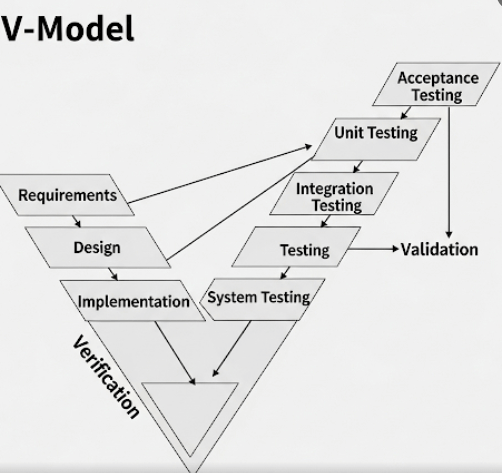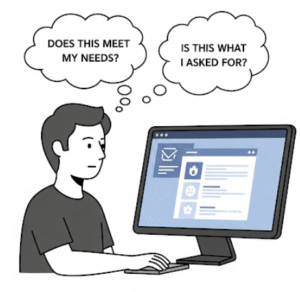- Testing Strategies
- A Strategic Approach To Software Testing
- Test Strategies for Conventional Software
- Black-Box and White-Box Testing
- Validation Testing
- System Testing
- The Art of Debugging
- Product Metrics
- Software Quality
- Metrics for Analysis Model
- Metrics for Design Model
- Metrics for Source Code
- Metrics for Testing
- Metrics for Maintenance
Introduction to Validation Testing
Validation testing is a crucial phase in the software quality assurance process that focuses on ensuring the software system, as a whole, meets the customer’s actual requirements and expectations. Unlike verification, which asks “Are we building the product right?”, validation addresses the question: “Are we building the right product?” It is performed after unit and integration testing, often on a complete and integrated version of the software, to confirm its fitness for use in the real world. This type of testing ensures that the final software product fulfills the user’s needs and business objectives, aligning the developed system with stakeholder vision.
Purpose and Objectives of Validation Testing
The primary purpose of validation testing is to provide confidence that the software system is fit for its intended use and environment. Its key objectives include:
- Fulfilling User Requirements: Ensuring that all user-defined requirements and expectations are met by the software’s functionality and behavior.
- Meeting Business Needs: Confirming that the software solves the actual business problems it was designed to address.
- Completeness Verification: Validating that all specified features and functionalities are present and working correctly.
- Functionality Confirmation: Thoroughly checking the overall functionality from an end-user perspective.
- Building Stakeholder Confidence: Providing assurance to customers, users, and other stakeholders that the system is ready for deployment and will perform reliably.
Where Validation Testing Fits in the Process
Validation testing typically occurs at the later stages of the software testing life cycle, after individual components have been unit-tested and integrated. It marks a shift from developer-focused internal testing to customer-focused external validation.
Relationship with Verification
- Verification: Focuses on the internal consistency and correctness of the software artifacts (e.g., code, design documents) against specifications. It’s about building the product right.
- Validation: Focuses on the external behavior and overall system compliance with user needs. It’s about building the right product.

Both verification and validation (V&V) are complementary and essential for comprehensive software quality assurance.
Key Aspects and Activities in Validation Testing
Validation testing involves a range of activities designed to simulate real-world usage and confirm that the software delivers the expected value.
System Testing
Often, validation testing is performed concurrently with or immediately after system testing. System testing evaluates the complete, integrated software product to verify that it meets specified requirements. This includes functional and non-functional tests.
Acceptance Testing
A critical part of validation testing, Acceptance Testing is the final phase where the software is tested by the end-users or clients. It determines whether the software is ready for release and meets the criteria for user acceptance.
Types of Acceptance Testing
- User Acceptance Testing (UAT): Performed by actual end-users in a simulated or production-like environment to validate the software against their real-world business scenarios and requirements.
- Business Acceptance Testing (BAT): Focuses on validating that the software aligns with the organization’s business goals and processes, often involving business stakeholders.
- Contract Acceptance Testing (CAT): Conducted to ensure that the software adheres to the specific terms, conditions, and requirements outlined in a contractual agreement between the developer and the client.
Challenges in Validation Testing
Despite its importance, validation testing can present several challenges:
- Ambiguous Requirements: Vague or incomplete requirements can make it difficult to determine if the software truly meets user needs.
- Environment Setup: Setting up a realistic testing environment that mirrors the production environment can be complex and resource-intensive.
- User Availability: Ensuring the availability and active participation of actual end-users or business representatives for UAT can be challenging.
- Scope Creep: New requirements or changes identified during validation can lead to scope creep and delays.
Best Practices for Effective Validation Testing
To maximize the effectiveness of validation testing:
- Clear Requirements: Ensure that requirements are clear, unambiguous, and testable from the outset.
- Early Involvement: Involve users and stakeholders early in the requirements and design phases to gather accurate needs.
- Realistic Scenarios: Develop test cases based on realistic business scenarios and user workflows.
- Dedicated Environment: Use a dedicated testing environment that closely resembles the production environment.
- User Training: Provide adequate training to users involved in acceptance testing.
- Structured Feedback: Establish a clear process for collecting, prioritizing, and addressing feedback from validation testers.
